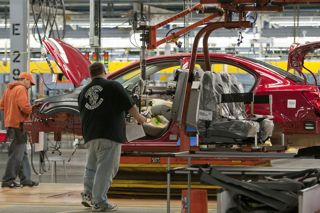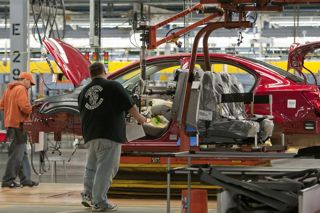In Lake Orion, MI, General Motors (GM)has retooled their car factory to maximize efficiency. According to motortrend.com, low energy lighting, thinner paint layers on cars, and clever reuse of heated air will increase the energy efficiency of the plant.

Maureen Midgley, GM’s director of Global Manufacturing Engineering, says that the two landfills used to power the plant will create enough energy to power 3500 homes.
The EPA says landfill gases are comprised of about 50% methane and about 50% CO2.
Power Partners Resource Guide, a publication of uspowerpartners.org–a parternership between the electric industry and the Department of Energy, says that landfill methane is made when bacteria decompose organic material in the absence of oxygen. Landfill gases, or LFGs, are extracted from landfills using a series of wells and a blower/flare or vacuum system. The gases are then transported to a central area where they are processed. Energy is then generated using a variety of different technologies, including internal combustion engines, turbines, microturbines, and fuel cells. According to the EPA, most landfills use turbines and internal combustion engines.
GM’s Manager of Green Energy, Rob Threlkeld, tells SciJourner that the Lake Orion plant will use a boiler system to generate energy.
LFGs aren’t only being used in Michigan. According to the EPA, there are 551 operational landfills across the entire United States in 2011, including 11 in Missouri. There are also approximately 510 more landfills that are potential sites for LFG power. The use of LFGs also directly affects greenhouse emissions and indirectly affects air pollution because they replace fossil fuels. (See “Converting Trash to Energy”)
The EPA says that methane gas is 21-times more potent than CO2 as a greenhouse gas. Landfills are the third largest human-generated methane producers, with 27.5 million metric tons of carbon equivalent.
This much methane could produce the same amount of global warming as the equivalent mass of CO2 that was released in 2009 alone.
Burning methane releases H2O and the much less harmful CO2 into the atmosphere, achieving near term beneficial climate change effects. However, EPA does not consider CO2 released in LFGs a contributor to climate change, because the carbon comes from recently living biomass and would have released CO2 if it had been outside of the landfill. LFGs are also a renewable resource.
Rob Threlkeld, GM’s Manager of Green Energy, says that currently four of GM’s plants are being powered by LFGs. The plants were chosen for LFG power because of their proximity to landfills that are useable for power. He also said that GM has been a leader in renewable resources. They are currently the second largest user of landfill power in the U.S., and are pioneering the field of solar power.
Other power saving measures in the Lake Orion plant include lighting that shuts down as the assembly line powers down and new technologies in the painting department that will use 50% less energy per vehicle, says Threlkeld.
The Orion plant will be building the compact car, Buick Verano, and the subcompact, the Chevy Sonic. According to motortrend.com, the Sonic will be the only subcompact car built in the U.S. and all the plant’s energy efficiency efforts are to make the Sonic a profitable car.
According to GM the Chevy Sonic will get around 40 mpg on the highway, and is available in a five-door hatchback and a four-door sedan. The hatchback will cost about $14,635 and the sedan will cost about $13,735. It will debut in the fall of 2011.

This work is licensed under a Creative Commons Attribution-NonCommercial-NoDerivs 3.0 Unported License









The visit was useful. Content was really very informative.
this article was useful? tells alot about whats going on with General Motors.
this was usefull i think im goint 2 get a lambo when i get old but cars could desroy the eath 1 day for real :gamba
you really know about cars nice job keep doind what you do
your article really opened my eyes:arhh